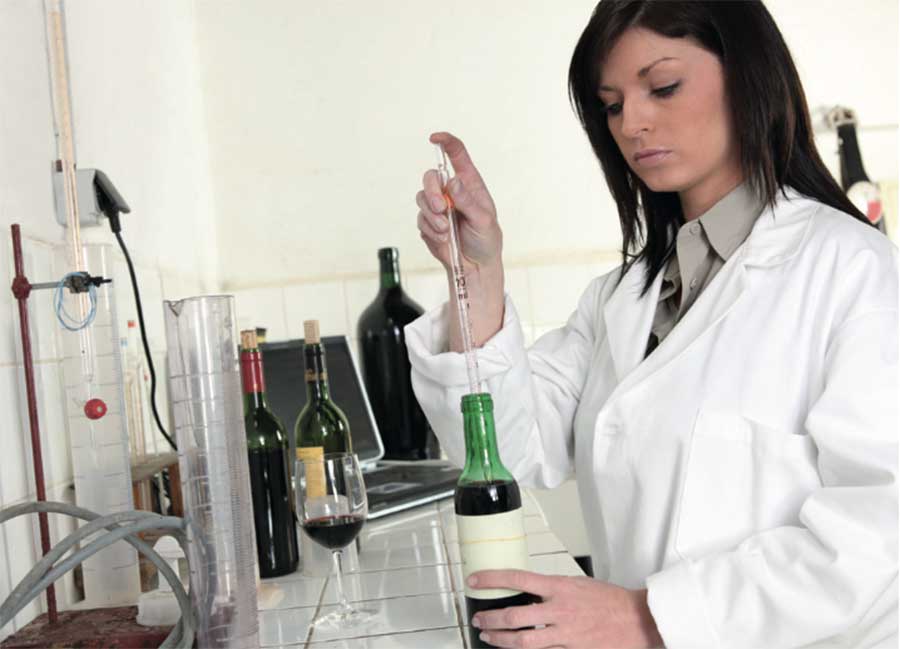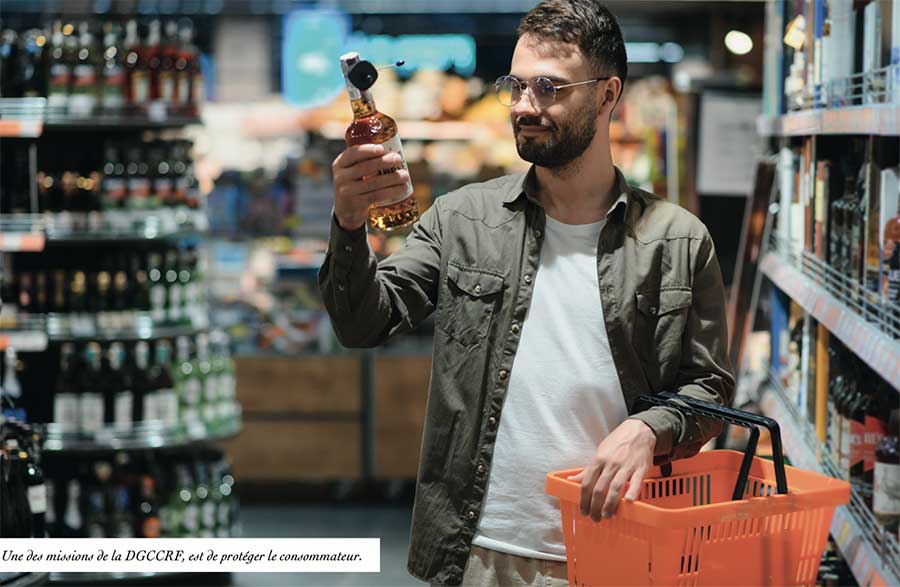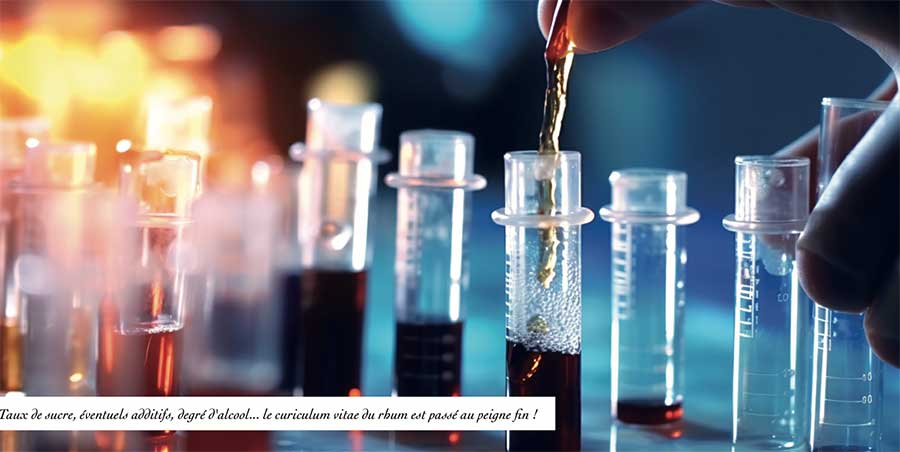Checks, age of rum, presence of sugar and additives, misleading claims, distributor liability… Benjamin Nardeux, head of the Alcoholic Drinks Division (BN), and Guillaume Pupier, editor in charge of spirits (GP) at the Directorate-General for Competition, Consumer Affairs and Fraud Control (DGCCRF), take stock of the rules in force. Prepare to be surprised!

What are the DGCCRF’s missions?
BN: There are several of them. Our first mission is to protect consumers, particularly in their dealings with companies. For example, investigators will check that product information is fair, that pre-contractual conditions are legally correct, that products are placed correctly on the shelves, that the right prices are charged, that advertising is not misleading… They also work on the composition of products to check that there is no deception, or the presence of prohibited additives, for example. The DGCCRF will also be checking for falsification of quality marks, deception such as the francization of a product, and misleading commercial practices…
GP: We also play a role in regulating competition in the market. As part of this, we monitor unfair commercial practices, in particular relations between distribution networks and suppliers, cartel problems, dominant positions, etc. We therefore protect consumers, but also companies that comply with the regulations against those that do not, and therefore have a competitive advantage.
What are these missions as they apply to rum?
BN: The DGCCRF draws up the regulations governing the production and labelling of spirit drinks. At European level, we are the spokespeople for the French delegation. For example, it was the DGCCRF that asked for a maximum sugar content to be set for spirits, so that we could have thresholds that we could monitor more effectively. We also sit on the INAO.
In practical terms, how are the controls carried out?
BN: Every year, we plan our investigations, based on the sector being inspected (e.g. targeting gins, flavouring of rums, etc.) and a risk analysis. Data relating to the targeting of professionals and the volume of inspections to be carried out are sent to the investigators.
They supplement this information with their knowledge of the field and the local economic context, in order to define their scope of inspection. The investigators intervene directly at the production stage at operators’ premises (wineries, distilleries, etc.), on supermarket shelves, in wine shops, on websites, at trade fairs, and also at the import stage. It’s important to remind your readers that importers of spirit drinks have the same obligations as the producers they distribute.
What are the obligations of importers?
GP: Every product imported into the European market must comply with the same rules as those produced there. Some non-EU countries have rules that differ from ours, particularly on the flavouring of rums, the sugar content or even the raw materials used.
When their drinks are sold on the European market, they must comply with European standards, and it is the importer who will guarantee this and be liable in the event of a problem. Penalties will be imposed.
How do you check that a rum is compliant?
GP: First and foremost, we check the traceability of the company throughout the production chain. For the operator, this means recording every stage in the production of the rum, from the purchase of the raw materials, to the processing stages (fermentation, distillation), ageing, blending and so on, right through to the marketing of the finished product.
We can also take samples of the product and send them to the joint laboratory department, which will carry out a detailed analysis of its composition: alcohol content, ageing in wood, volatile substance content, sugar content, addition of colouring caramel, the raw materials used, etc.

Do you ever carry out checks following complaints?
BN: Companies can report their competitors’ practices to us. Most alerts are made at local level, to our investigators, who specialise in wines and spirits and know the producers and markets.
The DGCCRF first checks that this information is well-founded, and will only initiate controls if the initial observations of the agents show that there are grounds for investigation.
GP: We are also in contact with management and defence organisations (ODG) for geographical indications or AOCs who have noted, for example, that their indication is being misused on their labelling. For example, Martinique rums must be produced entirely in Martinique: fermentation, distillation, ageing, etc.
Operators who buy bulk Martinique rum and have it aged in mainland France will write “Martinique rum” on their bottles, but this is prohibited.
Even if these rums are not AOC?
GP: Yes. The protection of GI and AOC names goes very far at European level. As soon as there is any mention of Martinique on the labelling (such as a map of the island, the term Madinina…), this is considered to be a usurpation of the Martinique AOC.
The ODG will first contact the operator to warn them that they are making a usurpation and that they must change their labelling, and that if they do not do so, after a certain period the DGCCRF will be notified. It also happens that we detect this type of problem ourselves and intervene on our own initiative.
BN: Sometimes the Member States or the European Commission itself contact us to make us aware of problems.
For example?
GP: For example, ageing in the Sistema solera.
Let’s talk about the age of rum. What are the rules?
GP: The rules are very clear, and have not changed since the first European regulation on spirit drinks in 1989. Only the age of the youngest alcoholic component can be indicated. With the exception of single casks and vintages, rums are blends of several ages.
So any references such as “this rum has been aged up to 9 years”, “this rum is a blend of 6 to 23 years”, “this rum includes rums some of which are over 50 years old”, etc. are strictly forbidden. This applies to bottle labelling, advertising, internet presentations, trade fairs, exhibitions and even magazines.
So we’re going to have to get up to speed here at Rumporter!
BN: Laughs. It wasn’t me who said that!
GP: After that, it’s more the operator who supplied the commercial messages that’s at fault.
What about Solera rums?
GP: The labelling of Solera rums is ambiguous for consumers. And as we’ve said, it shouldn’t be. Often it says “sistema solera”, with a fairly high number. 25 for example. This gives the impression that it’s the age of the rum. In fact, some people will tell you that it’s the average age or the oldest rum. In any case, it’s ambiguous for the consumer, and the labelling needs to be corrected.
BN: Even the fact that the term ‘anos’ has been removed from most labels doesn’t change the problem. The fact that there is still a figure on the label suggests that it refers to the age of the rum.
When a rum does not comply with the regulations, it is downgraded to “rum-based spirit drink”?
BN: In fact, this designation is not authorised by the regulations. All products that do not comply with the production rules laid down in European Regulation 2019/787 cannot use the word “rum”. For example, spiced rums cannot be sold as “rum-based spirit drinks”, only as “spirit drinks”. But it is possible to use the word “spiced rum” under certain conditions.
Which conditions?
BN: All the alcohol present must be rum, and the product must be flavoured with spices, not spice flavourings… And that’s not all. The words “rum” and “spiced” must be the same size and in the same font. And the words “spirit drink” must be in the same field of vision.
GP: We are particularly vigilant when it comes to spiced rums, because when they are placed on a shelf alongside aged rums, their colour creates a risk of confusion for consumers. They think it’s rum when it’s not.
And what about Rhum arrange?
GP: It hurts my heart a little because I’m from Réunion, but this term is not authorised by the regulations. On the other hand, ‘arrangé’ can be used quite freely. You can write ‘pineapple rum’, for example, as long as you’re really using pineapple and not a flavouring.
Don’t forget, of course, to add the words “spirit drink” in the same field of vision, or “liqueur” or “rum punch” if there are more than 100 grams of added sugar.
BN: All these rules were added after the European regulation, in 2021, at the request of the French authorities, in order to better protect consumers.
Flavouring is banned in rum, but what exactly is involved?
GP: It’s a concept to be taken in its broadest sense. Whether it’s adding vanillin, natural flavourings, artificial flavourings, fruit flavourings or macerating wood shavings directly in the rum… then it becomes a spirit drink, but it’s no longer rum.
Third-country brands are often accused of not complying with the regulations. What is really the case?
GP: We can’t name specific brands, but since 2016 we’ve been putting a lot of pressure on rum controls in general (rum from the French overseas departments and third countries). At the time, we used to take around ten samples of rum a year to have them checked in the laboratory, but now we have over 50.
And it’s a lot more when it comes to labelling checks. At the time, many rums from third countries were either very sweet or flavoured. Some rums were sweeter than certain soft drinks! But since the educational limit of 20g per litre came into force, our analyses show that there has been a real improvement in practices.
There are fewer and fewer errors. As far as flavouring is concerned, we’re still seeing it on rums from third countries, but here too the market is generally becoming healthier.
What about rums from the French overseas departments?
BN: There are fewer non-conformities with rums from the French overseas departments than with those from third countries. In the past, there have been a few instances where sugar content or obscuration levels have been exceeded. In other words, the sum of all the additions (caramel colouring, sugar, etc.).
GP : On the other hand, we quite often see differences in alcoholic strength. It should be measured at 20° Celsius; if it’s measured at 30°, the alcohol expands and this distorts the TAV results. The fact that the rum has been aged or that caramel or water has been added can also cause problems.
Are there any frauds involving the raw material?
GP: Cane juice is very unstable, so we don’t see any problems there. In fact, the transfer of cane juice is banned in Martinique and Guadeloupe, but is authorised in Réunion and French Guiana.
What about molasses?
BN: We had been alerted by the industry to the possibility of molasses being transferred from Guadeloupe to Martinique, but our checks showed nothing.
What’s more, this is authorised in the case of rums bearing the all-too-frequently forgotten geographical indications “rhum des Antilles françaises” or “rhum des départements d’outre-mer”.
The latter can be made from a blend of rums distilled in Guadeloupe and Martinique. It is therefore true that Guadeloupe GI rums are transported to Martinique.
And on Réunion, what about blends of molasses and agricole rums?
GP: It’s allowed, we just can’t use the term “agricole” any more. To come back to the question of raw materials. Under European regulations, only three raw materials can be used to produce rum: vesou, molasses and the syrup obtained from making cane sugar.
This last term is sometimes misinterpreted, but it refers to the syrups obtained during sugar production before the crystallisation stage.
It is also known as battery syrup or lacuite syrup. Outside the French overseas departments, particularly in mainland France, it has been observed that some people use raw sugar such as panela, muscovado and jaggery as the raw material for rum.
These are obtained by heating the cane juice, as for battery syrup, except that the water evaporates completely. The raw material for rum has to be liquid. So we’re talking about spirits, not rum.
BN: In any case, we’ve never seen raw materials that don’t come from sugar cane.
Is the ester content regulated?
GP: As far as volatile substances (other than methanol) are concerned, which are responsible for taste, there are no specific regulations. It’s even a quality factor. For example, in the great flavour, there must be at least 800 grams per litre. Some non-EU countries consider esters to be potentially hazardous to health, but this is not the case in Europe.
What about methanol?
GP: As methanol (which is harmful to health) is metabolised mainly from the pectins present in the pips, this is of little relevance to rum.
What do you need to know if you want to set up your own distillery or go into independent bottling?
GP: The DGDDI is responsible for everything to do with setting up a distillery, storing alcohol in cellars or vats, making alcohol and buying stills. The DGPR is responsible for environmental safety regulations.
INAO is responsible for all matters relating to quality labels, geographical indications and AOCs. We are responsible for production processes and labelling.
Is it legal to age rum at home?
GP: Yes, if the barrels are small and not marketed, but it’s best to check with the DGDDI.
What other rules would you like to remind us of?
GP: On the shelves, whether in wine shops or supermarkets, the labelling must distinguish between spirits (spiced, arrangés, etc.) and rums. It should also distinguish between AOC rums from Martinique and GI rums from the French West Indies (even if they are produced by Martinique-based companies). The same goes for website categories.
BN: I’d also like to talk about the forthcoming obligation to indicate the list of ingredients and nutritional declarations. For wine, this obligation will apply in December 2023. For spirits, it remains optional.
Even if we do not yet have a precise date to communicate, as negotiations on this subject are about to begin, at the end of these negotiations, producers will have to indicate the list of ingredients and nutritional declarations on their labels. They need to be prepared for this change.
What is considered to be an ingredient in rum?
BN: An ingredient is something that is used in the finished product. Even in modified form: raw materials, additives, sugar, caramel, flavourings, etc.
Will this information have to appear on labels or via a QR code?
BN: That’s part of the debate. As far as wines are concerned, operators have the choice between a QR code that links to a website where the information can be found, or the label itself.
This flexibility may not be applied to rum, as some Member States, particularly Germany, are in favour of labelling on the bottle. To ensure that consumers are properly informed, it seems simpler to read a label than to have to flash a code.
What is meant by nutritional value?
BN: It encompasses the overall energy value, expressed in kilojoules or kilocalories per 100 ml. And the energy value of the various nutrients (fatty acids, carbohydrates, lipids, proteins, salts, certain minerals, etc.). This is already done for all food products.
One final question on ageing: are continental ageing and tropical ageing regulated?
GP: When a product claims to be aged in one of these ways, we first check that it has been aged in the place indicated. It’s true that the proportion of angels will be different, higher in the tropics. After that, the DGCCRF does not judge organoleptic effects.
On the other hand, we do check that a rum from the DOM XO has been aged for at least 6 years on site. An XO wine brandy that has been aged in mainland France must have been aged for 10 years. So the difference is taken into account at a certain level.


